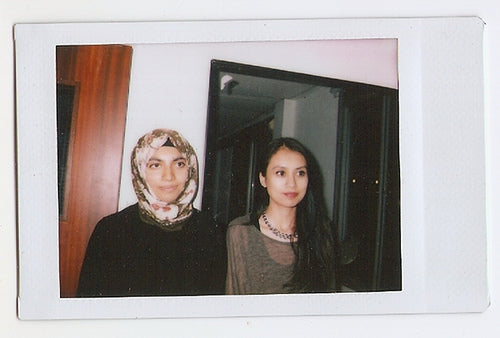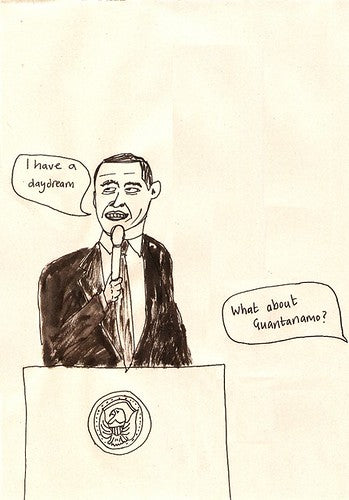
At Work With: Sofia Niazi & Rose Nordin, OOMK

The first issue of OOMK (One of My Kind) was published in early 2013. Published from London by three (now two) young designers trying to find their way in the creative industry, each issue uses a theme to pull together a mix of political observation and creative showcase. We look at the week ahead for editor/curator Sofia and designer/curator Rose as their second issue themed ‘Print’ is published.
Where are you today?
Rose: We’re at OOMK HQ in South Kilburn Studios. The studio is based in North London and we’ve been part of this creative community project for about 6 months now. It’s quite a unique space, there are a few designers and musicians here but there’s also an anthropologist, a hat maker and a radio station. Sofia is sitting at her table right now; it has a really big plank of wood across it. We’ve been meaning to sort it out since we got here. I'm sitting at my lovely table. Sofia always tells people that my table is her table when they come to visit, it's a bit awkward when we're both in.

Sofia: I’m sitting at my table, it has a big plank of wood on it but I’m so used to it now, it would feel like there was something missing if we threw it out. I always tell people my table is Rose’s table, they wouldn’t understand about the wood.
What can you see from the window?
Sofia: Right now I can’t see anything from my window because the shutter key has gone missing, only my shutter key has gone missing though which is suspicious. I should probably go and search for it or make a missing key poster but I’ve noticed that someone has left a cupcake on my table, big mistake to leave food on my table, it’s now half a cupcake.
Rose: I can see the local estate kids running about outside. They often end up on our roof, but today they are on the pavement.
How many emails are waiting in your inbox?
Rose: We’ve got 99 emails in our inbox but they're mostly just spam and love letters. Some of the spam looks quite interesting but Sofia gave me a lecture about clicking strange links and starting correspondences with strangers, she watches Catfish a lot and says it always ends badly.

Here’s an especially alarming email we received recently. If OOMK really is appearing in a Yahoo terrorist search we are shocked and appalled. How dare they.

What’s your favourite magazine this morning?
Sofia: This morning we’re looking though the Design Studio Handbook by Computers Arts magazine, does that count as a magazine? It’s really nice to look at and is packed with lots of great advice for staring up a design studio, sadly nearly all the pictures are of male designers though. That’s actually one of the reasons why Rose is so keen to start up a female design studio, she has a lot more experience of working in the design world and feels quite strongly about male dominated structures that can make female designers feel undervalued. The thought of earning a living from producing our own design and illustration work is really exciting and something we’ve both been working towards both academically and through jobs. We love making OOMK but in order to make it sustainable we feel like we need to have a business that can prop it up, I think Heiba (our trainee) is pretty keen for us to start up a café but Rose doesn’t drink coffee and all coffee tastes the same to me so I don’t think we’d be very good at that.

Rose: Oh Comely is our magazine hero, we've got this months copy to beam over.
This is the first time we've featured a team together in the At Work With interview. Describe how you collaborate – who does what?
Rose: When we started OOMK last year it was me, Sofia and Sabba, but Sabba is working full time as a designer now so it's mainly just me and Sofia, she still contributes and supports OOMK and we really value her opinion about content and design. It terms of who does what; I design the layout, edit images and make the hand drawn titles. The design is really inspired by our connection to zine culture, which is why we like to use the typewriter font and hand drawn lettering.

Sofia: When we start putting a new issue of OOMK together it’s a really collaborative process. We brainstorm how we’re going to incorporate the theme into the issue and what the main ideas or topics are that we want to address, we also discuss which artists and illustrators we’ve been noticing and how we could include their work. The work in OOMK comes from all sorts of places; submissions, conversations, emails, events, twitter, tumblr, someone’s cousin who is good at drawing. We’re really blessed to have creative friends too, so many of the articles and artworks have come from our friends putting us in contact with other people. As well as sourcing content and doing illustrations for OOMK I also handle the accounts and distribution, I think that decision was based on our GSCE Maths grades which I won’t disclose, but my one was higher than a B and rhymes with hay.

We’ve also got two new people in OOMK, Heiba Lamara and Hudda Khaireh. Heiba joined us a couple of months ago as part of our studio trainee contract and we've been ‘studio traieeing’ her ever since. She helps us run workshops, edits content and she recently curated an OOMK installation at Nour Festival based on oral tradition. Heiba is a really important part of the OOMK team, she's really organized and she's got lots of great ideas. Hudda also helps with events and content, she’s a constant source of positivity and enthusiasm and despite having a super busy schedule she is always happy to give her time and energy.

The new issue of OOMK is themed ‘Print. What does print mean to you?
Rose: When I graduated, I felt quite overwhelmed trying to enter the design industry. When I became involved in the small press and zine scene in London, I found making printed things to be an outlet for being creative without that industry framework giving me permission. I like the processes of printing and working through a project slowly and in a considered way. But at he same time I like the immediacy of having something on paper without being edited. Of course, this led to OOMK issue 2 which focuses on the power of print as a subject.

Sofia: Print always makes me think of posters and pamphlets. It reminds me of iconic campaigns, beautiful graphics but also the chicken shop flyers that get posted through my letterbox. Print can be so special and valuable, like screen printed artworks or precious books from archives but it can also be completely disposable, like newspapers or flyers. I was reading some books about the Internet and I came across this discussion about how the Internet exists in a state of ‘unfinish’. I think that’s what I love about print, you can make something or write something and it can be finished.
OOMK tackles serious subjects in a subtle, disarming manner, not least what it's like to be a young Muslim woman in Britain today. Some might presume a clash between your progressive political outlook, your warm humour, and religious conservativism. How do you reconcile these things?
Sofia: I was listening to a talk by the Nigerian writer Chimamanda Ngozi Adichie the other day in which she talked about the danger of a single story. She spoke about moving to America to go to university when she was younger and coming into contact with Americans who would so often approach her with a sense of pity. She said that the look of pity was to do with the single story of Africa that had been perpetuated through the media, a story of famine, war, poverty and disease. I feel like presumptions about who Muslims can and cannot be also come from a single story that has been perpetuated through the media. One of the reasons that we were so keen to start OOMK was so that we could start writing and drawing our stories and concern ourselves with the subjects that were important to us instead of getting tangled in other people’s ideas.

Rose: I think it’s uncommon in the media to find realistic, three dimensional representation of people, especially women. Most magazines aimed at women have a focus that obscures real life priorities, angled toward very particular, isolated subjects. They aren’t always necessarily bad, but they tend to focus on a simple, unrealistic focus on the external; ignoring the multifaceted needs and nature of people. I think our magazine reflects our personalities and interests and I think this flows, because like everyone, we exist in multiple roles at once and if they didn’t function together, we wouldn’t function. We like drawing, funny comics, community and we feel strongly about justice and this is reflected in our magazine, as it is in our personalities.

What are you most looking forward to this week?
Sofia: Angela Davis is doing a talk in London later this week, she’s an activist who played a significant role in the Black civil rights movement so I’m really looking forward to hearing her speak about ‘Palestine and the struggle for liberty in a world of growing militarisation, privatised repression and the proliferation of prisons’.

Rose: I’m part of the Alternative Press Collective with Amneet Johal. It’s a group that promotes and organises small press, zine and comic events. I’m really excited because next year we are collaborating with the Radical Book Fair and the Bishopsgate Institute for a large scale project. So I'm looking forward to catching up with Amneet and setting up website content for the event.
What are you least looking forward to this week?
Rose: The hypocrisy in the media surrounding the death of Nelson Mandela has been hitting me a lot. The same newspapers that support Israeli occupation are lamenting the death of a freedom fighter they once framed as a terrorist. I keep seeing the coverage in the same vain and I expect it to last the week and I’m not looking forward to more. I’d like the same politicians and media outlets to try aspiring to the ideas of Mandela, rather than falsifying speeches on an emotional bandwagon.
What will you be doing after this chat?
Rose: Sharing some Thai food with the OOMK girls hopefully.
Sofia: I’m going to have to get up and find that shutter key.


